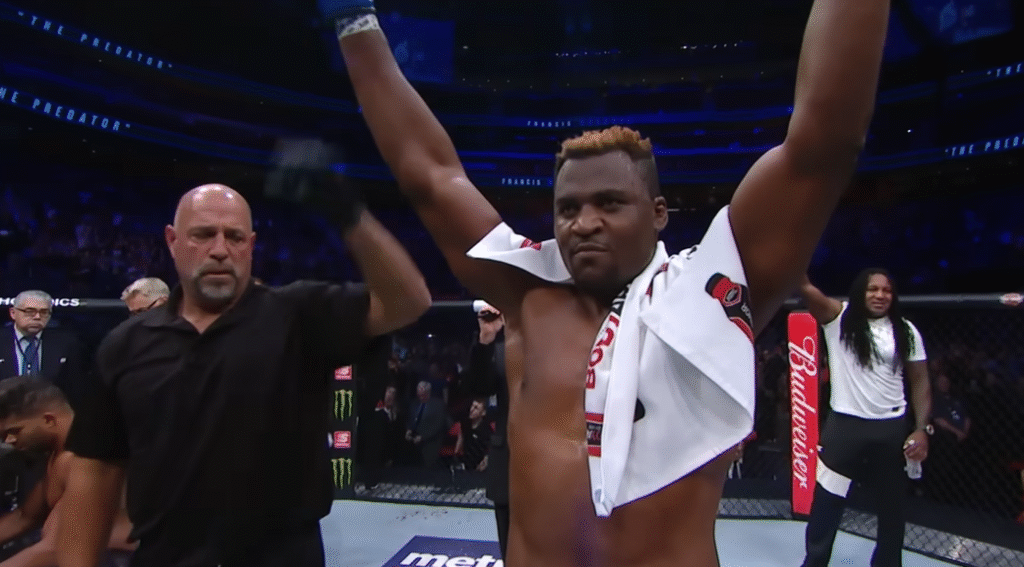Francis Ngannou’s weight has evolved into more than just a fight card statistic; it is now a statement of intent, a changing strategy, and a mirror reflecting the changing nature of combat sports. Ngannou, who officially weighed 257 pounds (117 kg) during his UFC tenure, has adopted a fluid approach to mass, modifying it based on the situation and the competition. He was surprisingly heavy, even by heavyweight boxing standards, weighing 272.6 pounds before facing Anthony Joshua in 2024. Shortly before that, he acknowledged that he weighed 293 pounds, which sparked intense interest from critics, rivals, and even his fans.
Francis Ngannou – Personal and Professional Information
| Attribute | Details |
|---|---|
| Full Name | Francis Zavier Ngannou |
| Date of Birth | September 5, 1986 |
| Place of Birth | Batié, Cameroon |
| Nationality | Cameroonian, French |
| Height | 6 ft 4 in (1.93 m) |
| Reach | 83 in (211 cm) |
| Official Fight Weight | 257 lbs (117 kg) |
| Heaviest Known Weight | 293 lbs (133 kg) |
| Recent Boxing Weight | 272.6 lbs (123.6 kg) |
| Division | Heavyweight (MMA & Boxing) |
| Team | Xtreme Couture, formerly MMA Factory |
| Fight Style | Orthodox Striker |
| MMA Record | 18 Wins – 3 Losses (13 KO, 4 Submissions) |
| Notable Opponents | Stipe Miocic, Ciryl Gane, Jon Jones, Anthony Joshua, Tyson Fury |
| ESPN Profile Link | https://www.espn.com/mma/fighter/_/id/3933168/francis-ngannou |
Francis worked just under the 265 lb limit in the UFC, modifying his physique to produce explosive power without sacrificing agility. However, he has leaned heavily—both literally and figuratively—into mass in boxing, where competitors are not constrained by an upper weight limit. He outweighed Anthony Joshua by more than 20 pounds when he stepped into the ring at 272.6 lbs, indicating a deliberate change in fighting style.
Versatility has become increasingly popular in the heavyweight divisions of boxing and mixed martial arts in recent years. While fighters like Tyson Fury (280 lbs) represent a more lumbering, but incredibly effective, brawler archetype, fighters like Ciryl Gane (247 lbs) and Jon Jones (249 lbs) represent sleek athleticism. Ngannou fits both descriptions; he is incredibly explosive for his size and is clearly experimenting with endurance when lifting larger weights.
Francis has established himself as a dynamic model for the changing heavyweight prototype in addition to being an athlete by embracing this adaptability. He expands for impact rather than speed, a strategy that has yielded devastating results, such as his record-breaking punch on the PowerKube at 129,161 units. Not only is that figure impressive, but it also effectively illustrates how his weight multiplies force output when combined with technique.
Performance-based optimization has replaced weight-cut theatrics as the primary function of weight in combat sports during the last ten years. That evolution is aptly captured by Francis Ngannou’s methodology. He challenges opponents to handle his brute force by purposefully growing larger while carefully balancing the trade-off between speed and endurance. He uses weight as a tool to exert pressure, command presence, and shorten fights rather than just gaining weight.
These decisions are about legacy for Francis, not just about battles. His ascent has been especially motivating because he was born into poverty in Cameroon and was compelled to work in a sand quarry as a child. He went from being a homeless newcomer in Paris to an internationally renowned athlete through perseverance. His physical metamorphosis also has emotional significance. Every extra pound appears to represent the aspirations of innumerable African youths who are watching him as evidence that success is achievable.
Ngannou has expanded strategically, both physically and symbolically, and is now a phenomenon outside of sports. Celebrities, fitness celebrities, and other fighters often admire his physique. He was referred to as one of the scariest punchers Mike Tyson had ever seen. Regularly going viral are Joe Rogan’s podcast segments about Ngannou’s strength. Videos of Dwayne “The Rock” Johnson praising his work ethic have been shared online. These endorsements come from a shared understanding of the body as a weapon and a message, not from hype.
But the weight story changes once more at 38. Precision is necessary as one ages, and Ngannou’s team has apparently put in place cutting-edge procedures to make sure he stays strong and mobile. He now regularly incorporates underwater resistance training, cryotherapy, and customized recovery techniques into his regimen. He is optimizing his size rather than merely maintaining it by incorporating state-of-the-art performance science.
This balance is especially creative in the context of contemporary combat readiness. The majority of fighters still concentrate on getting as fit as possible right before a fight. Ngannou’s group, on the other hand, is engineering longevity—maintaining a frame weighing over 270 pounds without compromising explosiveness. Heavyweights’ perception of body mass as a variable rather than a fixed characteristic is changing as a result of this incredibly effective strategy.
It’s crucial to remember that not everyone agrees with this approach. Critics claimed that Ngannou’s extra bulk hurt him during his bout with Anthony Joshua because it made his movements seem a little slow. Others, however, argued that the same weight made him more resilient and enabled him to consume shots that would have broken smaller men. His fights are still characterized by this conflict between speed and power, which makes every weigh-in feel like a calculated disclosure.
Ngannou has operated with more independence since leaving the UFC, examining what it means to be a combat sports entrepreneur as well as a fighter under contract. This journey includes his physical reinvention. He changes viewers’ perceptions of weight in sports and motivates aspiring athletes by demonstrating what is physically feasible at almost 300 pounds.







